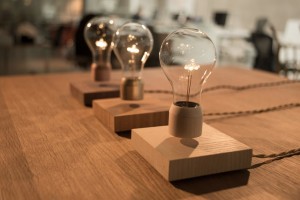Flyte is a levitating light which hovers by magnetic levitation and is powered through the air. The amazing flyte hovering light uses magnetic levitation and wireless technology to rotate continuously with almost no friction. It is described as a new way to experience light, one that is free from the constraints of gravity and enhances wireless technology to receive power. Combing tesla laws of induction with the signature bulb, it is powered through the air making it safe and harmless as it needs no batteries and only uses low voltage.
Packed with sensors and advanced hardware, the electro-magnetic base is elegantly designed and crafted in Sweden from sustainable oak, ash and walnut. By touching the foundation, the light can be switched on and off, and when removed, the base can charge a smartphone. It uses a series of magnets which are powered without touching.
The Flyte bulb works by a combination of induction and magnetism. The unit is formed of a base, which is connected to a standard power supply, and the specially made lightbulb. While gravity pulls the lightbulb towards the base, it is pushed up by the opposing force of the magnetism. At the same time, the bulb is being powered by induction. The electromagnetic field heats the coil in the bulb, as it would heat a pan on a cooker.
The lightbulb contains a cap, in which there is a magnet with a coil that receives the electricity and powers the light. It is powering the light through the coil using magnetic levitation, and hence uses a combination of two types of technologies, levitation and induction.
In practice, this works by placing the bulb at the centre of the wooden base. When the light comes on, the unit in operation can be turned on and off by tapping the surface of the base. The wow factor is that the lamp is levitating and is being powered through mid air. As well as lighting up the bulb, the pad on which it levitates above can be used as a wireless recharger for mobile phones.
This type of inductive charging is becoming increasingly common in the consumer electronics market. Wireless charging pads are now available in some McDonalds restaurants and Starbucks cafes in the UK. The levitating technology could be used as a speaker system that would rotate in the air just as the bulb does in the Flyte product or maybe some restaurants could use the Flytes instead of candles in the middle of their table settings.
For more information please visit: http://www.flyte.se

